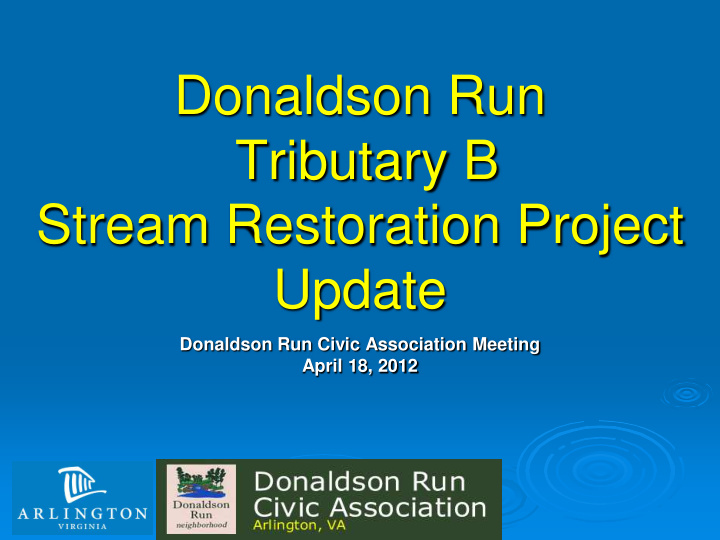



Donaldson Run Tributary B Stream Restoration Project Update Donaldson Run Civic Association Meeting April 18, 2012
Donaldson Run watershed Donaldson Run Watershed Boundary Tributary C Taylor School Tributary B Tributary A
‘Big picture’ concepts Past land use and drainage decisions have severely impacted County streams Watershed improvements and in-stream restoration efforts are both essential Urban stream corridor damage must be addressed comprehensively Stream restoration accomplishes multiple resource management objectives Neighborhood partnership is essential
Sediment and Nutrients Unrestored Tributary B Restored Tributary A with visibly lower with visibly higher sediment content sediment content
County/Donaldson Run Civic Association Partnership 10+ year partnership Stream restoration top neighborhood priority NCAC approved Tributary B funding in December 2007; County Board 2008; DES providing additional funds Extensive County/DRCA public process: meetings, workshops, stream walks, newsletter articles, park signs, Citizen articles, and other media coverage
KEY PROJECT FACTS: • Approved Neighborhood Conservation Program Project • 1,400 linear feet to Upton street • 26% impervious cover in watershed • Natural channel design approach
Updates from prior design to current (~95%) design Hydraulic analyses for FEMA permitting underway Vertical elevation of water main determined; design adjustments in process Storm pipe drainage inputs Inspection of pipes completed Easement process underway Finalizing design Advancement of planting plan and invasive plant management strategy Consideration of construction access, equipment type, future maintenance access
Storm pipe drainage inputs Verified pipe conditions Acquiring necessary easements Incorporating needed repairs/modifications into project design
30” Water Main Interim work completed to protect exposed pipe last year Few apparent conflicts with stream restoration design except at stilling basin – design adjustments in process Considering reinforced streambed crossings for future access to main if needed
Trees No change in tree impacts from project from 60% designs to current design One tree removed to protect water main (previously listed as a potential removal) One tree has fallen (previously listed as a removal) Project impact: 36 trees>10” diameter, 72 trees overall
Invasive Management & Planting Plan Goals: To restore forest structure and function To support recreational use and aesthetics
Kudzu Invasive Plants 85-95% invasive species in the shrub and ground layers invasive species present on both park and private properties 27 different species
Implications Invasive management considerable component of the project Project requires integrated planting and invasive plant removal 4-6 year planting and invasive plant maintenance schedule Complete removal of invasive species is likely not possible Most successful if private citizens are involved in invasive management
2011 Invasive Management Actions Invasive plant removal workdays – spring & fall Invasive plant workshops Upshur St - Hosted by Amy White Stuart St - Hosted by Sarah & Jeffrey Knight Invasive plant replacement mini-grants Developed a native plant list for DR homeowners
Future Actions Spring and fall events - Tributary A & B Invasive plant workshop(s)? – Tributary A & B Native plant rescue Creating a RIP team (Remove Invasive Plants) Coordination with Arlington Master Naturalists
Planning & Chemical Control Limited chemical application in 2011 Contract spraying – Summer 2012 Invasive management plan – Tributary A
Invasive Management “Clean” equipment Mulch or mats for trees/shrubs Seed heavily • Protect trees and shrubs (deer) • Focus on stream banks • Target species • Coordinate invasive removal and planting • Timing of control will depend on plant life cycle • Flexible and adaptive • Budget
Planting Plan Site specific All plants will be native to Zachary Taylor Park Planting “zones” to account for habitat changes with elevation and distance from the stream. Special plantings for sensitive areas Multi-year to account for invasive control and natural forest succession
Scarlet oak Arrowwood Bluestem goldenrod Quercus coccinea Viburnum dentatum Solidago caesia
Zoned Planting - Example Slope Floodplain
Special Areas – Bare Slopes
Construction methods, equipment, & materials
Smaller materials and equipment
Tree protection techniques, Mats
Next Steps Finalize design work for storm pipe drainage inputs Obtain necessary easements Finalize planting plan and invasive plant management plan Develop construction access/staging plan Complete specifications including tree protection plan Target design completion by fall Construction schedule still TBD
Tributary A, June 2010 Stream restoration, watershed retrofits, Chesapeake Bay Preservation Ordinance, Stormwater Permit and more…. Learn more at: www.arlingtonva.us – search “Donaldson Run.”
Recommend
More recommend